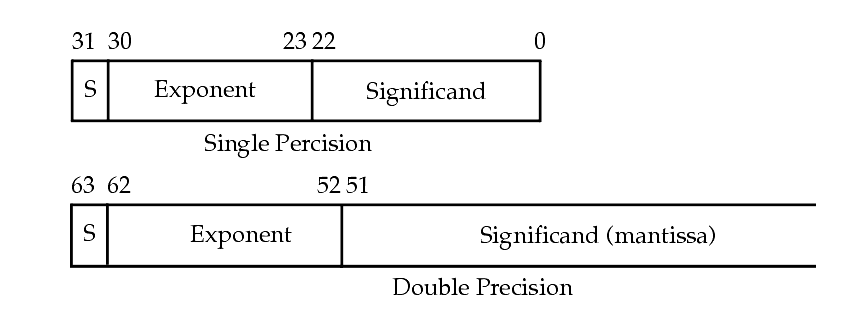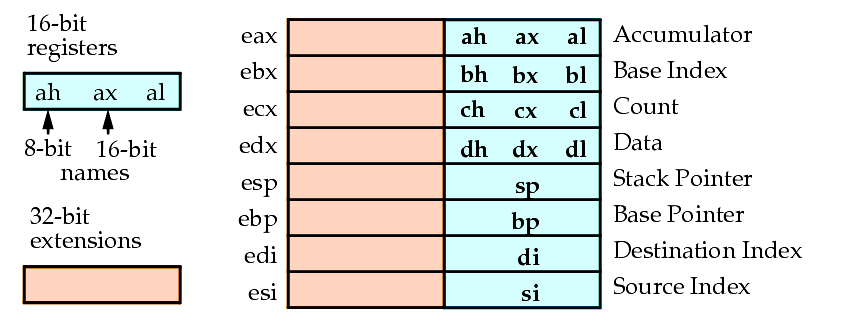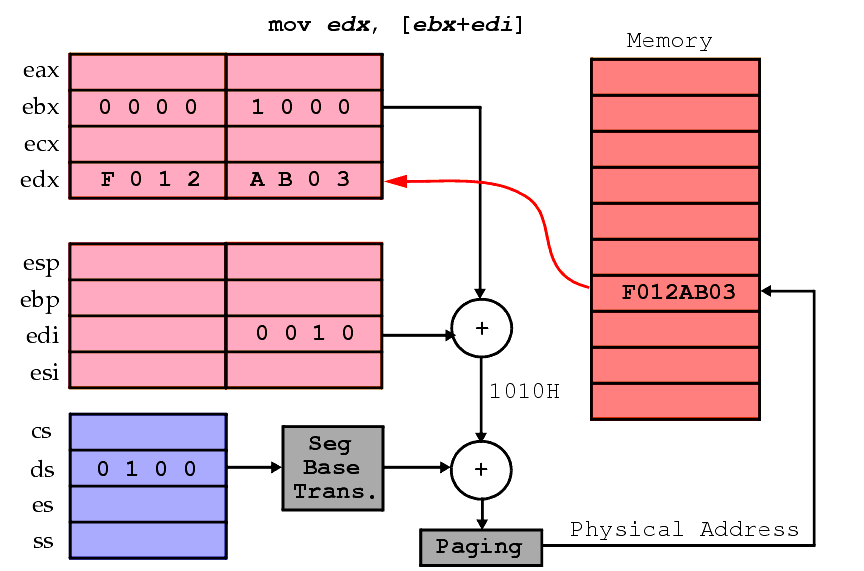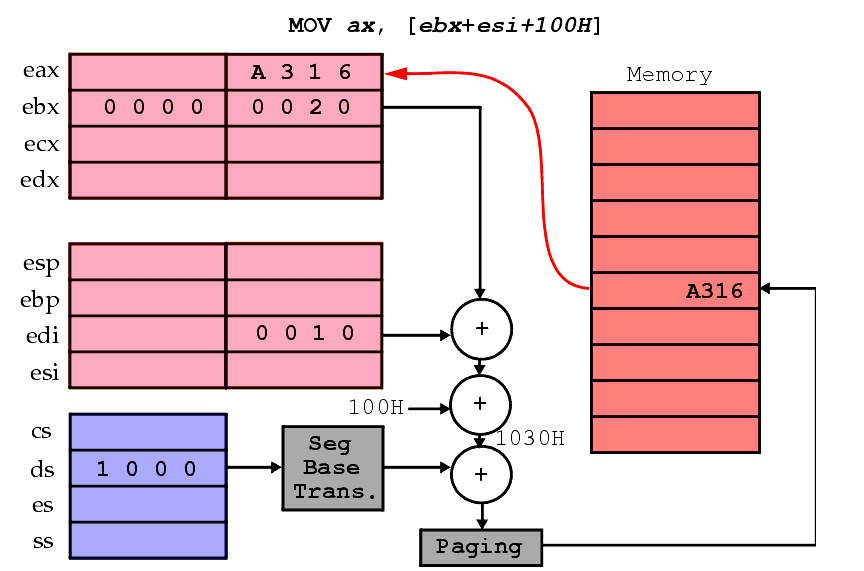Review conversion from one base to another in text as well as two's complement.
Table 1: ASCII (American Standard Code for Information Interchange)
| Dec |
Hex |
Sym |
Dec |
Hex |
Sym |
Dec |
Hex |
Sym |
Dec |
Hex |
Sym |
| 0 |
0 |
NUL |
32 |
20 |
|
64 |
40 |
@ |
96 |
60 |
` |
| 1 |
1 |
SOH |
33 |
21 |
! |
65 |
41 |
A |
97 |
61 |
a |
| 2 |
2 |
STX |
34 |
22 |
" |
66 |
42 |
B |
98 |
62 |
b |
| 3 |
3 |
ETX |
35 |
23 |
# |
67 |
43 |
C |
99 |
63 |
c |
| 4 |
4 |
EOT |
36 |
24 |
$ |
68 |
44 |
D |
100 |
64 |
d |
| 5 |
5 |
ENQ |
37 |
25 |
% |
69 |
45 |
E |
101 |
65 |
e |
| 6 |
6 |
ACK |
38 |
26 |
& |
70 |
46 |
F |
102 |
66 |
f |
| 7 |
7 |
BEL |
39 |
27 |
' |
71 |
47 |
G |
103 |
67 |
g |
| 8 |
8 |
BS |
40 |
28 |
( |
72 |
48 |
H |
104 |
68 |
h |
| 9 |
9 |
TAB |
41 |
29 |
) |
73 |
49 |
I |
105 |
69 |
i |
| 10 |
A |
LF |
42 |
2A |
* |
74 |
4A |
J |
106 |
6A |
j |
| 11 |
B |
VT |
43 |
2B |
+ |
75 |
4B |
K |
107 |
6B |
k |
| 12 |
C |
FF |
44 |
2C |
, |
76 |
4C |
L |
108 |
6C |
l |
| 13 |
D |
CR |
45 |
2D |
- |
77 |
4D |
M |
109 |
6D |
m |
| 14 |
E |
SO |
46 |
2E |
. |
78 |
4E |
N |
110 |
6E |
n |
| 15 |
F |
SI |
47 |
2F |
/ |
79 |
4F |
O |
111 |
6F |
o |
Table 2: ASCII (American Standard Code for Information Interchange)
| Dec |
Hex |
Sym |
Dec |
Hex |
Sym |
Dec |
Hex |
Sym |
Dec |
Hex |
Sym |
| 16 |
10 |
DLE |
48 |
30 |
0 |
80 |
50 |
P |
112 |
70 |
p |
| 17 |
11 |
DC1 |
49 |
31 |
1 |
81 |
51 |
Q |
113 |
71 |
q |
| 18 |
12 |
DC2 |
50 |
32 |
2 |
82 |
52 |
R |
114 |
72 |
r |
| 19 |
13 |
DC3 |
51 |
33 |
3 |
83 |
53 |
S |
115 |
73 |
s |
| 20 |
14 |
DC4 |
52 |
34 |
4 |
84 |
54 |
T |
116 |
74 |
t |
| 21 |
15 |
NAK |
53 |
35 |
5 |
85 |
55 |
U |
117 |
75 |
u |
| 22 |
16 |
SYN |
54 |
36 |
6 |
86 |
56 |
V |
118 |
76 |
v |
| 23 |
17 |
ETB |
55 |
37 |
7 |
87 |
57 |
W |
119 |
77 |
w |
| 24 |
18 |
CAN |
56 |
38 |
8 |
88 |
58 |
X |
120 |
78 |
x |
| 25 |
19 |
EM |
57 |
39 |
9 |
89 |
59 |
Y |
121 |
79 |
y |
| 26 |
1A |
SUB |
58 |
3A |
: |
90 |
5A |
Z |
122 |
7A |
z |
| 27 |
1B |
ESC |
59 |
3B |
; |
91 |
5B |
[ |
123 |
7B |
{ |
| 28 |
1C |
FS |
60 |
3C |
< |
92 |
5C |
\ |
124 |
7C |
| |
| 29 |
1D |
GS |
61 |
3D |
= |
93 |
5D |
] |
125 |
7D |
} |
| 30 |
1E |
RS |
62 |
3E |
> |
94 |
5E |
^ |
126 |
7E |
~ |
| 31 |
1F |
US |
63 |
3F |
? |
95 |
5F |
_ |
127 |
7F |
|
ASCII: Stored using an assembler directive db:
Word-sized (dw) and doubleword-sized data (dd):
Little endian: Least significant byte is always stored in the lowest memory location.
Floating Point Formats
For single percision, the sign bit + 8-bit exponent + 24-bit mantissa = 33 bits !
The mantissa has a hidden 1 bit in the leftmost position that allows it to be stored as a 23-bit value.
The mantissa is first normalized to be >= 1 and < 2, e.g., 12 in binary is 1100, normalized is 1.1 X 23.
The exponent is also biased by adding 127 (single) or 1023 (double), e.g. the 3 in the previous example is stored as 127 + 3 = 130 (82H).
Floating Point Formats and Directives
There are two exceptions:
The number 0.0 is stored as all zeros.
The number infinity is stored as all ones in the exponent and all zeros in the mantissa. (The sign bit is used to indicate + or - infinity.)
Directive is dd for single, dq for double and dt for 10 bytes:
Format of an assembly instruction:
Stores a symbolic name for the memory location that it represents.
A register, an immediate or a memory address holding the values on which the operation is performed.
There can be from 0 to 3 operands.
Let's cover the data addressing modes using the mov instruction.
Data movement instructions move data (bytes, words and doublewords) between registers and between registers and memory.
Only the movs (strings) instruction can have both operands in memory.
Most data transfer instructions do not change the EFLAGS register.
m
Direct (eax), Displacement (other regs)
Any of eax, ebx, ecx, edx, ebp, edi or esi may be used.
Any combination of eax, ebx, ecx, edx, ebp, edi or esi.
A second variation includes: mov eax, [
ARR+ebx]
m
Base relative-plus-index
A second variation includes: mov eax, [ebx+edi+4]
A second variation includes: mov eax, ebx*2+ecx+offset
Scaling factors can be 2X, 4X or 8X.
Note: mov really COPIES data from the source to destination register.
n
Never mix an 16-bit register with a 32-bit, etc.
n
None of the mov instruction effect the EFLAGS register.
The value of the operand is given as a constant in the instruction stream.
n
Use b for binary, q for octal and nothing for decimal.
n
ASCII data requires a set of apostrophes:
Register and immediate addressing example:
Transfers between memory and al, ax and eax.
Usually encoded in 3 bytes, sometime 4:
Displacement instructions are encoded with up to 7 bytes (32 bit register and a 32 bit displacement).
Direct and displacement addressing example:
Note: Direct addressing (using al) requires 3 bytes to encode while Displacement (using bx) requires 4.
Register Indirect addressing:
Offset stored in a register is added to the segment register.
The memory to memory
mov is allowed with string instructions.
Any register EXCEPT
esp for the 80386 and up.
For
eax,
ebx,
ecx,
edx,
edi and
esi: The data segment is the default.
For
ebp: The stack segment is the default.
Some versions of register indirect require special assembler directives byte, word, or dword
Does [edi] address a byte, a word or a double-word?
Base-Plus-Index addressing:
Effective address computed as:
Base registers: Holds starting location of an array.
n
Any 32-bit register except esp.
Index registers: Holds offset location.
n
Any 32-bit register except esp.
Base-Plus-Index addressing:
Register Relative addressing:
Effective address computed as:
seg_base + base + constant.
Same default segment rules apply with respect to ebp, ebx, edi and esi.
Displacement constant is any 32-bit signed value.
Base Relative-Plus-Index addressing:
Effective address computed as:
seg_base + base + index + constant.
Designed to be used as a mechanism to address a two-dimensional array.
Base Relative-Plus-Index addressing:
Data/Code Addressing Modes
Effective address computed as:
seg_base + base + constant*index.
Code Memory-Addressing Modes:
Used in jmp and call instructions.
Absolute jump address is stored in the instruction following the opcode.
This far jmp instruction loads cs with 1000H and eip with 00000000H.
A far call instruction is similar.
A displacement is added to the EIP register.
This constant is encoded into the instruction itself, as above.
n
Short jumps use a 1-byte signed displacement.
n
Near jumps use a 4-byte signed displacement.
The assembler usually computes the displacement and selects the appropriate form.
Jump location is specified by a register.
Any register can be used: eax, ebx, ecx, edx, esp, ebp, edi or esi.
Intrasegment jumps can also be stored in the data segment.
The stack is used to hold temporary variables and stores return addresses for procedures.
push and pop instructions are used to manipulate it.
call and ret also refer to the stack implicitly.
Two registers maintain the stack, esp and ss.
A LIFO (Last-in, First-out) policy is used.
The stack grows toward lower address.
Data may be pushed from any of the registers or segment registers.
Data may be popped into any register except cs.




































